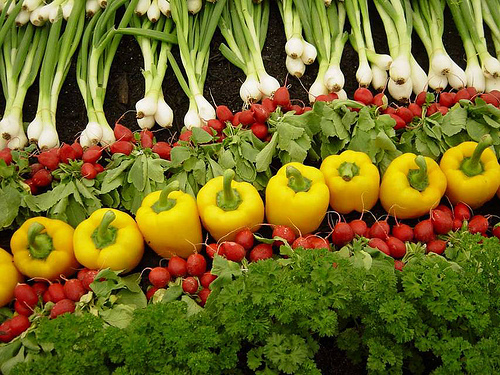Supermarket Shopping 101: Read This Before You Hit the Grocery Store
Ed note: Last week, First Lady Michelle Obama was the guest editor for the iVillage website. She worked with the editors there to create a weeklong series of great articles and videos with advice for families looking to Rev Up their Back to School Routine and introduce healthy new habits for everyone in the household. The editors of iVillage asked readers to share their own strategies for making changes stick in their families.
Before you can cook for your family, you need to know how to grocery shop for foods you’ll use. From how to make a list to making healthy choices, consider this your go–to cheat sheet.
Making a List:
Can't live without your smartphone? Download one of the many shopping apps out there, like Out of Milk or Grocery iQ, to create a list that will live with you at all times.
If you have some meat or chicken in your freezer, a fresh vegetable in the crisper and a starch in your pantry, you’ve got building blocks for a great dinner. But that can get old pretty quick (not to mention expensive!), so try this easy five-night meal plan formula:
Two Meat or Chicken/Starch/Vegetable Dinners Like:
- One-Dish Chicken and Potatoes
- Steak and Gorgonzola Fajitas
- Chicken Cutlets with Spicy Garlic Kale
- Grilled Basil and Garlic Pork Chop
One Pasta or Pizza Dinner Like:
- Lemony Whole Wheat Pasta Spirals with Broccoli and Parmesan
- Creamy Spaghetti with Ricotta, Zucchini and Basil
- Roasted Cherry Tomato and Rosemary Pizza
- Smoky Corn and Black Bean Pizza
One Taco Dinner Like:
One Bean Dinner Like:
Click here for a week's worth of dinner recipes and a printable shopping list!
Choose one recipe for each night of the week and draw up a list of those ingredients, plus staples like milk, cereal, bread and eggs. To avoid walking in circles around the supermarket, divide your ingredient list into categories such as “Produce,” “Dairy & Eggs,” “Meat,” “Canned Goods,” “Dry Goods” and “Frozen Foods.” That way, you know where to go and what you need. (And hopefully steer clear of impulse buys!)
Like Santa Claus, you should always check your grocery list twice. Before you grab your keys and head to the store, do a quick check of your pantry, refrigerator and freezer to make sure you don’t already have any of the items on your list. Not only will you avoid coming home with an extra carton of eggs, you might also notice that you’re nearly out of an everyday staple like orange juice or butter.
When to Shop:
Some say that Wednesday nights are the best day to hit the supermarket. Produce and meat are often restocked mid-week and it’s often the day that grocery stores reduce prices on expiring items and advertise sales. But some savvy shoppers prefer weeknight evenings or early mornings or evenings on the weekend, when stores tend to be less busy. Whenever you decide to shop, just don’t do it on an empty stomach – hunger pangs will tempt you to stray from your shopping list.
Navigating the Store:
You’ve got your list, you’ve got your cart – let’s get shopping! Focus on the perimeter of the store first – that’s typically where you’ll find the produce, meat and dairy sections, which stock fresh, whole foods that should comprise the bulk of your shopping list. Then navigate your cart toward other essentials, like canned goods (beans and tomato sauce), grains (pasta, rice, boxed couscous or quinoa mixes) and frozen foods (fruits, vegetables, seafood).
Steer clear of the cookie, snack and soda aisle until after you’ve collected everything on your list – at that point, your cart should be full, which might make you feel less tempted to buy things you don’t need. By always heading to the essential areas of the store first, you’ll train yourself to form a shopping pattern that’s healthier – and, in time, will get you in and out of the store faster.

Photo Credit: US Environmental Protection Agency
Making Good Choices:
If you’re sticking to a meal plan, there should be more fresh than packaged ingredients in your cart, but there’s nothing wrong with store-bought foods, as long as you choose wisely. Here are a few things to keep in mind:
- Look for packaged foods with short ingredient lists. Pay close attention to the first ingredient listed, which is what the food is mainly comprised of – which can help you determine whether a product is a healthy choice.
- Consider what’s in season. If you’re shopping for fruits and vegetables in the winter, you’ll save money and get better quality produce if you buy frozen, rather than fresh. Likewise, look for bargains on deliciously ripe tomatoes and berries in the summertime.
- Your supermarket’s salad bar is a treasure trove of ready-to-go produce, especially lettuce. If you’re one of those people who end up pitching more vegetables than you consume, just buy what you need from the salad bar.
- Look for cereals and bread made with whole grains or whole wheat, not “refined” wheat, which has been stripped of its nutrients. Also check for sugar and corn syrup – many “healthy” cereals are loaded with sugar.
- Meat and bread freeze beautifully, so take advantage of sales and buy in bulk!
- Looking for healthy snack options? Try plain popcorn, frozen edamame, nuts, dried fruit, low-fat yogurt, hummus and raw veggies or salsa and baked tortilla chips.
